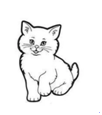
According to the Trademark Examination and Adjudication Guidelines for Combination Trademarks, if the graphic part of the trademark is identical or similar, which easily confuses the relevant public as to the source of goods or services; it is determined to be a similar trademark. For example:

A combination trademark is a trademark composed of any two or more of the six elements - words, graphics, letters, numbers, three-dimensional signs and colors. Comparing with pure text or pure graphic trademarks, the composition of the combination trademarks are more diversified, which integrate the designer's multiple ideas. Can two trademarks be simply judged as similar trademarks just because one of the components - graphical part - is similar or identical? In my opinion, when judging whether such combination trademarks constitute "similar marks", we can compare and consider from the following aspects:
1. Whether the design of the graphics is an expression of the common characteristics of the same thing
Graphics elements can contain different elements, such as people, animals, plants, geometric shapes, etc. As part of trademark design, graphic elements should follow the common characteristics of these elements and also need to have their own individual differences. When graphic elements are designed to express common characteristics of the same thing but lack creativity, for example, the expression form of "flower" is " ", the expression form of sun is "
", the expression form of sun is " ", and the expression form of cat is "
", and the expression form of cat is " ", and if two trademarks are directly identified as similar trademarks because all graphics in the combination trademarks are expressions of these common characteristics and ignore other composing elements, it is obviously broader protection for the graphic elements that is the expression of common characteristics, which is not good for others' use. Therefore, when determining whether combination trademarks constitute similar trademarks due to its similar graphics, whether the graphic design merely has common characteristics without creativity should be considered.
", and if two trademarks are directly identified as similar trademarks because all graphics in the combination trademarks are expressions of these common characteristics and ignore other composing elements, it is obviously broader protection for the graphic elements that is the expression of common characteristics, which is not good for others' use. Therefore, when determining whether combination trademarks constitute similar trademarks due to its similar graphics, whether the graphic design merely has common characteristics without creativity should be considered.
For example:

Both the designated goods of the Trademarks 1 and 2 are all related to "wool and artificial yarns". The graphic part of Trademarks 1 and 2 respectively expresses the common characteristics of "wool", and considering that they have different words, the trademarks can be distinguished, so the two trademarks are not judged as similar trademarks.
2. Do the graphical elements belong to public domain elements?
Public domain elements are not created by someone, and there is no exclusive right holder, so when the graphic elements in the trademark are public domain elements, it should be allowed for different market entity to make further creation on the basis of public domain elements. If only certain entities are allowed to use or register the public domain element as part of a trademark while prohibiting others from doing so, it will impede the legitimate use of other operators. Therefore, when a trademark consists of public domain elements, its protection cannot be extended and others cannot be prohibited from using or registering it.
For example:

The graphic elements in Trademarks 1 and 2 are "The Hall of Prayer for Good Harvest of the Temple of Heaven ", which belongs to the public domain and is not created by the cited trademark right holders. In addition, the overall compositions of the trademarks are different, and the words part is completely different. In this case, there is an obvious difference between the two marks in terms of overall visual effect and composition elements. For relevant public, they can more easily distinguish them from each other. Even if they are used simultaneously on similar services, there is high chance they will not cause confusion or constitute similar trademarks.
3. The overall composition and text part of the graphic are clearly distinct
Given the diversification of combination trademarks, besides the graphics part, other constitutive elements shall also be taken into account. Therefore, when both trademarks contain similar graphic elements, the composition layout and textual composition of graphics, the pronunciation and meaning of word also should be compared. If there are obvious differences in these aspects between the two marks, the relevant consumers would not be confused or misrecognized and they can coexist over the same or similar goods and services.
For example:

Both Trademark 1 and Trademark 2 contain similar graphic elements, but due to their different composition of graphic elements, expression techniques, design styles, word compositions, word calls and meanings, the common consumers can distinguish them with ordinary attention. Therefore, they can coexist.
In conclusion, as for the two marks containing similar device, when determine whether they are similar marks shall consider different factors. As for the device part bearing originality, if the graphical elements of the trademark applied later are similar to those of prior filed or registered mark with originality, it is easy to cause confusion and misunderstanding amongst the relevant consumers. Therefore, these two trademarks should be judged as similar trademarks. However, as for graphical elements that merely express common features or public domain elements or when the overall composition shape of the trademarks, word compositions, pronunciations and meanings are obviously different, it should not be mechanically judged as similar trademarks; instead, more consideration should be taken comprehensively.


Follow us






